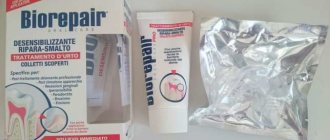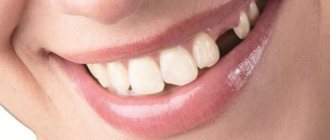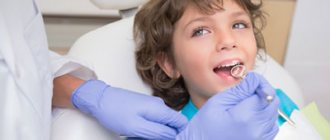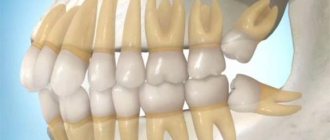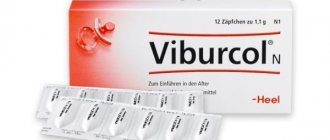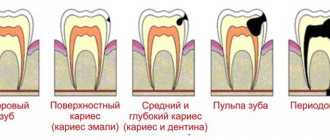Milk teeth are temporary elements of the maxillofacial skeleton, 80% consisting of hard (bone) tissues and formed during the embryonic development of the fetus. The complete replacement of milk teeth ends in a person during puberty at the age of 12-13 years (less often, the last milk teeth fall out by the age of 14-15 years). The number of temporary teeth is 40-60% less than permanent teeth: in an adult, the total number of teeth on the upper and lower jaw can range from 28 to 32 pieces. The anatomy of primary teeth also differs from the structure and structure of the molars: primary teeth have lower and narrow crowns, and their root system is poorly developed compared to the roots and root canals of permanent teeth.
Anatomy of baby teeth
Functions of primary teeth
In terms of their functional characteristics, milk teeth are no different from molars. The main function of teeth as one of the elements of the dentofacial apparatus is to hold, grind, grind and chew food, which, in the process of mechanical grinding, is processed by digestive enzymes contained in the salivary secretion and enters the pharynx and esophagus. If one or more baby teeth fall out (or are surgically removed) prematurely, the child’s risk of developing gastrointestinal diseases increases, the root cause of which is insufficient chewing of food and the creation of additional stress on the fragile gastrointestinal tract.
Why do we need baby teeth?
Before the eruption of the first milk teeth, which usually occurs at the age of 5-8 months, the gums perform the function of grinding and grinding. If a baby with 1-2 teeth is given a piece of apple, banana or cookie, he will be able to crush and chew it due to the high force of interaction of the gums with external factors (food, rodents, teethers, etc.). The normal eruption of baby teeth and proper care for them are especially important in children over 10 months of age. At this age, the active introduction of complementary foods begins (about ½ of the total diet consists of various foods and drinks), and impaired chewing function can lead to poor absorption of vitamins and minerals and the development of related diseases and pathologies.
Baby teeth
In addition to mechanical grinding and chewing of food, primary teeth in children of different ages perform other important functions, namely:
- participate in the formation of speech (the structure, shape and location of the teeth can influence the production of certain sounds, for example, the sound “r”);
- form a bite;
- are responsible for facial expressions and facial symmetry.
Types and functions of teeth
At an older age, correct bite allows the child to form a comfortable psychological background, develop self-confidence and more easily adapt to social factors and new people.
Important! Many parents are mistaken in believing that temporary teeth do not need careful care, since new teeth will appear in their place. This is wrong. If a baby tooth is affected by caries, untimely treatment or its absence can lead to the penetration of cariogenic bacteria into the periodontal tissues and provoke their inflammation. The risk that a permanent tooth will erupt, already affected by caries, in this case is almost 35%.
The child was diagnosed with extensive microbial damage to dental tissues
Molars in children: numbering
The number of permanent teeth in children increases by 8 pieces. After a change in the dentition (this happens between the ages of 7 and 12 years), 4 more teeth grow on each jaw, which are called the first and second large molars. These teeth have serial numbers 6 and 7. The teeth that grow in place of the first and second primary molars retain their serial number (4 and 5), but change their name: molars four and five are called small molars (another name is premolars).
Molar growth chart
Fact! A twelve-year-old boy should have 14 permanent teeth in any row (28 teeth in total).
Why not 32?
80% of adults have 32 teeth. This number is considered the physiological norm, since 32 tooth buds are formed in the fetus during intrauterine development. The upper/lower dentition is closed by the third molars, which have a serial number of 8. These teeth are popularly called “wisdom teeth” because they often erupt in adulthood. The norm is the appearance of “eights” in the period from 17 to 35 years, but in some people the third molars may not erupt at all or may not emerge in full (for example, 1-2 teeth out of four).
The most common problem is that wisdom teeth can take quite a long time to grow.
The eruption of these teeth is quite painful and is often accompanied by inflammatory processes. In some cases, a person may need to take potent antibacterial drugs (mainly from the group of semisynthetic penicillins or macrolides). In case of complex intertwined roots or other complicated cases, third molars can be removed under general anesthesia.
Problems with the growth of wisdom teeth
The number of teeth a child has depends on his age and characteristics of his residence (nutrition, climate, ecology, social conditions). The physiological factor is also of great importance. Knowing the pattern of appearance of baby and molar teeth in a child will help to better navigate the ongoing processes and notice deviations from existing norms in time, so parents should have this information and know how to use it.
Video - The order of eruption of baby teeth
In order to maintain the beauty and health of a child’s teeth, parents, first of all, need to know their structure, as well as have an idea of how temporary teeth differ from permanent teeth, and what care they require. This will help you avoid many mistakes, saving your baby from unpleasant sensations and negative emotions, and you from unnecessary troubles and worries.
Features of the structure (anatomy)
Milk teeth, like permanent teeth, are located in special recesses that are located in the jaw, and their number corresponds to the number of teeth. Such pits are called dental or alveolar cells or alveoli. The alveoli are internally separated by hard partitions (according to the number of roots). The cavity of the alveolar cell is filled with periodontal fibers. It is a dense collagenous mass with a high degree of vascularity, containing a large number of lymphatics, small blood vessels and capillaries. Thanks to the periodontium, the bone matrix of the dental cell can bind to the root cement.
Diagram: what baby and permanent teeth look like in children
The tooth and its tissues are nourished by arteries that pass through a small hole in the root apex. Through the same hole, excess fluid is removed from the tooth and periodontal tissues, and the nerve trunks responsible for the innervation of the tooth (its sensitivity) pass through.
Hard fabrics
The structure of a baby tooth, although it has minor differences from permanent teeth, differs little from the structure of the molar dental system. Hard tissues make up the bulk of the teeth, although the total density of the hard elements of primary teeth is several percent lower than that of permanent teeth.
Tooth structure
- Enamel. This is the outer shell of the tooth, which performs a protective and aesthetic function. Almost 98% consists of inorganic compounds and is the strongest tissue in the human body. The health of molars in the future depends on proper care of enamel in infancy and early preschool age.
- Cement. This is a very hard bone tissue of a specific type that surrounds the root and neck and protects them from external influences. It consists of cells similar in structure to osteoblasts and intercellular fibrous substance. Dental cement improves the fixation of periodontal fibers to the alveolar plate and tooth root, and also provides a supporting function.
- Dentine. This is the underlying tissue of the tooth, covered by the dental crown and cementum. About 68% of dentin consists of minerals from the apatite group, the remaining volume is occupied by water and organic components (nucleic acids, peptides, acid and alkaline phosphatase, albumin, proteoglycans, etc.).
Baby teeth in children
Inside the tooth root there are anatomical cavities in which there are blood vessels, nerve fibers, and lymphatic vessels. These cavities are called root canals. Their number corresponds to the number of roots in the tooth: incisors and canines have one root canal, molars have 3 roots (two buccal and one palatal).
Loss of baby teeth
Soft fabrics
The soft elements of the tooth are represented by pulp, which fills the pulp chamber. This is fibrous connective tissue in the form of loose fibers, which contains a large number of vessels of the circulatory and lymphatic systems, as well as nerve plexuses responsible for the innervation of the tooth and its sensitivity. The pulp of a baby tooth performs 4 main functions:
- participation in the formation of dental tissues (dentin), which are formed both before teeth eruption (primary dentin) and after eruption (secondary dentin), gradually leading to the filling of the intradental cavity and the build-up of bone mass;
- stimulates the regeneration of damaged, infected and necrotic tissues due to the formation of replacement dentin;
- prevents the spread of cariogenic bacteria into periodontal tissue;
- forms sensitive, pain and sensory perception (due to a large number of nerve trunks).
The structure of the dental pulp
Note! Some parents think that pulpitis (inflammation of the soft tissues of the tooth) is a disease that can only develop on the molars, so they do not pay enough attention to the child’s oral hygiene. Ignoring basic rules and regulations of hygiene, as well as manifestations and caries at this age can lead to periodontal damage and the spread of infection to the formed permanent teeth that appear after the loss of baby teeth.
Pulpitis
Timing of eruption
A child’s baby teeth may appear at six months or later; there is no special system here. No matter how hard parents try to find out exactly the time of teething, it is unlikely to succeed.
The appearance of the first tooth depends on many factors. This is influenced by genetic predisposition, type of nutrition, and physiological characteristics of the child.
Usually the incisors above and below appear first. On average, this occurs at 7-8 months or earlier. If the child is almost a year old and his first teeth have not grown in, then there is no need to worry.
Doctors say that eruption can begin up to one and a half years. Of course, a delay can also be caused by problems in the body - rickets or adentia. But both of these anomalies are not very common.
After the incisors, molars usually appear, and then the canines grow. By the way, the canine takes the longest to form – the tooth can appear in about two or even three years. After the fangs, the second molars grow - when these teeth emerge, the child is already three years old.
By about 3-4 years of age, children already have all 20 baby teeth. In total there should be 8 molars and incisors, there should be 4 canines. Don't worry if a couple of teeth are missing - they may appear later.
Sometimes children grow several teeth at the same time - two or four at once. Here you need to remember the rule: if the first incisor, molar or canine comes out, then pairs of them will soon follow.
It happens that a one-year-old child does not yet have a single tooth. As mentioned above, this may be due to the genetics and physiology of the baby.
READ When does the replacement of baby teeth with permanent ones begin?
But sometimes the reason may be that the gums are too thick, through which the tooth simply cannot come out. A child may have adentia, when in the gums from the very beginning there were not even rudiments for baby teeth.
Many parents want to know the exact time of teething in order to prepare in advance for possible symptoms.
Quite often, during cutting, children cough, they have a runny nose, and even bowel problems are possible. In addition, children begin to have restless sleep and refuse to eat.
It should be remembered that these symptoms do not always indicate the imminent appearance of a tooth. Sometimes they can indicate a cold and an infection.
During the period of teething, the child’s immunity is significantly reduced, so that some microbe can easily be introduced into the body.
To understand that the symptoms are caused by teething, you need to look in the mouth. If a small bubble appears on the gum, a tooth will soon grow.
Many parents are afraid when their baby starts coughing and runny nose before teething. In fact, this is not so scary: the whole point is that children produce a lot of saliva during the teething period.
Therefore, it enters the nasopharynx, throat and liquefies the stool. The reason for a runny nose is that the child cannot yet control the amount of saliva.
Another sign of rapid teething is itching of the gum tissue. When the gums begin to itch, the baby wants to put everything in his mouth, so it is better to remove all toys with sharp and small parts.
In addition, the child’s favorite things need to be thoroughly disinfected to prevent infection from getting into the mouth.
Basic anatomy
In total, there are three main elements that make up both milk and permanent teeth.
Table. Basic anatomical elements of a temporary tooth.
| Name | What it is? |
| Dental crown | The hard part of the tooth located above the gums. |
| Tooth neck | The part of the tooth that corresponds to the edge of the gum and connects the dental crown and root. |
| Tooth root | The lower element of the tooth, through which all its tissues are nourished. The root is surrounded by periodontal ligaments and periodontal fibers and fixed in the alveolar socket. |
Baby tooth
Anatomical features of the structure and development of primary teeth in children
Children's dentistry "Jewelry Work" successfully treats caries, pulp periodontitis and other diseases of children's teeth. In order for you to understand the causes of tooth decay, our dentists have prepared this material, which talks in detail about the structure of milk teeth, their characteristics, and the period of replacement of milk teeth with permanent ones. After reading the article, you will know useful information that will allow your child to save his teeth on time.
Milk bite
The primary bite consists of two dozen teeth, where there are incisors, canines, first molars, second molars, but no premolars. The color of the first eruption of teeth resembles milk cream in its shade. In terms of the shape of the crowns, baby teeth are similar to permanent teeth, but it should be borne in mind that the size of baby teeth is significantly smaller, the layer of hard tissue is thinner, so the dental cavity is somewhat larger.
During the critical period of root formation and resorption, the apical openings and root canals are quite wide, the border between the crown and the root of the tooth is clearly visible.
It should be emphasized that primary teeth have their own unique personal characteristics.
Deciduous incisors
The incisors of baby teeth are much more prominent than those of permanent teeth. The palate has no furrows. The distal angle of the maxillary lateral incisor has a greater rounding than the central incisor. Near the neck on the lateral incisor, the enamel ridge has less expressiveness, in contrast to the incisor located in the center. The tips of the incisors in the center of the maxilla may be curved toward the lips, and the roots of the upper central incisors may be flared. The incisors of the lower jaw are characterized by smaller sizes; the lower incisors are supported by flat roots with grooves on the lateral and medial sides.
Milk fangs
The crown of the upper primary canine is often shorter when compared with the size of the crown of a permanent tooth, and is characterized by a convex surface. The cutting edge of the primary fang has distinct tubercles, and the root of the fang has a rounded shape.
First primary molars
The crown of the first molar of the maxilla is stretched in the mesial-distal direction, the chewing surface has two cusps. The palatal surface is convex, the buccal surface of the tooth has a kind of ribbing, outlined by a pair of grooves.
The first primary molar is held in the upper jaw by three radiating roots with wide apical foramina. The crown of the lower first primary molar is oriented in the anteroposterior direction. Particularly worth mentioning are the strongly pronounced four cusps of the chewing surface and the developed enamel ridge. The lower first molar has two roots, widely diverging, the distal root is smaller and narrower than the mesial one. The buccal surface is also divided into distal and medial regions.
Second primary molars
The second upper primary molars are distinguished by a slightly beveled crown shape. The posterior buccal root is fused with the palatine root. In the area between the anterior lingual and posterior buccal tubercles there is an enamel fold.
The second primary molars of the lower jaw are similar in structure to the first permanent molars of the lower jaw (the only difference lies in the width of the divergence to the sides), they have 5 cusps, the most pronounced of which is the anterior buccal.
Resorption of the roots of baby teeth
Baby teeth are replaced by permanent teeth around the age of five. At the same time, two independent processes occur in the child’s jaws: the rudiments of permanent teeth begin to gradually grow, and the roots of baby teeth also gradually dissolve, giving way to a new dentition. The root to which the permanent tooth germ is closest is resorbed the fastest.
The rudiments of permanent teeth included in the anterior group are located at the lingual surface of the root of temporary teeth. The rudiments of the premolars are located between the roots of the primary molars. The rudiment of the lower premolar is located closer to the posterior root, and the upper one is much closer to the posterior root. As a result, the resorption of the roots of single-rooted primary teeth occurs from the lingual surface of the root, and then surrounds the root.
Resorption of the roots of primary molars occurs starting from the inner surface of the roots. At the moment of root resorption, granulation tissue is replaced by the pulp of baby teeth, resorption is completed by the time the permanent tooth erupts.
As noted above, the eruption of permanent teeth and the resorption of the roots of primary teeth normally proceed synchronously, although in practice the dentist may observe a significant change in the rate of resorption. Accelerated resorption, for example, is typical for baby teeth with dead pulp, teeth with inflammation, swelling, etc. If the rudiments of permanent teeth are absent for some reason, resorption slows down significantly.
Dentists take into account the nature of resorption of the roots of baby teeth, eliminating the consequences of periodontitis, pulpitis, during surgical and orthodontic interventions. It is important to know that teeth with resorbed roots are treated in a special order, including all stages, from treatment to installation of a filling.
Anatomy of primary and molar teeth: what is the difference?
Despite the fact that the functions of temporary and permanent teeth are identical, there are certain anatomical features that are manifested by differences in number, structure and root system. To make it easier to understand what exactly is the difference between baby teeth and molars, the table below provides a detailed comparative description.
Table. Features of the anatomy and morphology of primary and molar teeth.
| Criterion | Baby teeth | Permanent teeth |
| Quantity | 20 | 28-32 (extremely rarely the number of teeth can reach up to 33, which is one of the anomalies in the development of the jaw apparatus) |
| Which teeth form the bite? | Incisors, canines and molars. | Incisors, canines, premolars (small molars) and molars (large molars). |
| Root shape | The roots are straight, their length is several mm shorter compared to the roots of permanent teeth. | The roots are curved, complex interlacing of roots is possible (especially in the trailing molars, which are “wisdom teeth”). |
| Teeth color | White, cream, the color of milk or sour cream. Slight blueness possible. | The natural color of tooth enamel in permanent teeth is slightly yellowish. |
| Dental crown size | Small height against a background of large width. | The crown is narrower, but the height is several mm greater than that of baby teeth. |
| Crown shape | Pronounced bulges are noticeable. | Anatomical convexities are poorly expressed. |
| Presence of an enamel bead (enamel thickening) | Eat. | No. |
| Density and thickness of hard tissues | The degree of mineralization is lower, so the strength and density of baby teeth is lower compared to molars. | Enamel mineralization rates are higher, which ensures higher density and hardness of teeth. |
| The size of the apical foramina in the apex of the tooth root | Wide and freely passable. | Narrower. |
Features of the anatomy of baby teeth
Main parts of a baby tooth
Both permanent and baby teeth are formed during the embryonic period. The milk ones are formed first, and by the 4th month of development the permanent ones begin to form.
For some time, all these teeth are even in the same plane, but later a thin bone partition appears that delimits them.
All stages of formation are the same, which means that the structure of the teeth and the composition of their tissue are similar.
Incisors, molars and canines differ in appearance, this is due to their functions. Sharper and thinner incisors are needed to bite, canines to hold, and molars to grind food.
Despite the fact that the tooth is solid, it can be conditionally divided into three parts:
- crown - the upper and visible part, consisting mainly of enamel;
- neck - a slight narrowing at the border of the upper part and the root;
- root - a process that holds a tooth in the alveolus.
Primary incisors have an uneven, wavy edge. This is due to the peculiarities of teething; later these irregularities will disappear. There are also convexities on the surface of the molars: two or four tubercles. But this is already a permanent shape of the teeth and it will not change. You should pay attention to the spaces between the tubercles. This is where food debris most often accumulates, which can cause tooth decay.
Brushing your teeth at night is a must for maintaining oral health. This clears the enamel of plaque, which can cause infection.
If brushing your teeth is not possible, you can give your child a piece of hard cheese to eat. Thus, the enamel will be cleansed of pathogenic bacteria and the acid balance will be restored.
Order and timing of appearance
A child’s first teeth most often appear between the sixth and ninth months of life, but there are known cases of earlier teething (at 2-3 months), as well as temporary adentia in one-year-old children. In rare cases, a child is already born with from 1 to 3-4 teeth in the mouth, but such teeth, as a rule, are not very strong, are prone to destruction and coloring, and fall out before the physiological period.
Photos of teething in children
The timing of the eruption of the first baby teeth is influenced by many factors, for example:
- type of feeding (in children who are breastfed “on demand”, teeth appear 1-2 months earlier than in “artificial” babies);
- heredity;
- compliance with the complementary feeding schedule;
- climatic conditions of residence (children living in areas with short daylight hours are more likely to suffer from cholecalciferol and calcium deficiency and related diseases).
The first baby teeth usually begin to erupt at 6-8 months.
The teeth on the lower jaw (central and lateral incisors) usually erupt first. One-year-old babies develop canines and first molars in the second year of life. Baby teeth finally erupt at about 2-3 years of age (second molars).
Sequence of eruption and loss of primary teeth
The change of baby teeth begins in children at 5-6 years of age and ends by the age of twelve.
Permanent teeth
Understanding the structural features of a baby tooth begins with knowledge about the structure of permanent teeth, because the structure is identical. Based on location and tasks performed, there are 4 groups:
- Incisors, four on each jaw. Externally, the incisors resemble a chisel; their main purpose corresponds to the name: to bite off food, dividing it into large pieces.
- Fangs (two on top, the same number on the bottom), necessary for tearing the product and holding it in the mouth.
- Premolars (two on each jaw) that grind food.
- Molars, their number is from 8 to 12. The difference is explained simply: molars include “wisdom teeth”, sometimes missing: this is not a pathology, but a variant of the norm.
Milk teeth “live” 6-12 years.
An adult has 28-32 teeth, depending on the presence or absence of third molars.
Anatomy
The chewing unit consists of three parts:
- A crown located above the gum.
- A root that holds an organ in an alveolus (a kind of depression) that has one or more processes.
- The neck is the narrow area that separates the crown from the root.
The internal part is a cavity consisting of the root canal and the pulp chamber. Reliable connection with bone tissue is ensured by strong fibers. The ligamentous apparatus functions not only as a latch, but also as a shock absorber necessary when chewing.
Night feeding caries
This type of milk caries is designated by many terms: nursery (early preschool), kefir, nipple, bottle and early childhood caries. The term “night feeding caries” is used to designate the pathology due to the fact that the main reason for its development is the long-term persistence of night feedings, which reduces the quality of oral hygiene. Milk sugar and the lactobacilli contained in it, after consuming adapted milk substitutes, kefir and other dairy products, create a breeding ground for the proliferation of cariogenic flora, which is represented mainly by streptococci. Various strains of streptococci secrete acid-forming substances (butanoic, methylacetic, formic acid, etc.) that corrode tooth enamel and cause the development of caries.
Bottle caries
Kefir caries is an early form of caries and is diagnosed in children aged 10 months to 3 years. For treatment, fluoridation and remineralization of enamel with the help of special preparations are usually used, but in advanced forms of caries, classical treatment using a drill and removal of necrotically altered tooth tissue may be required.
What does bottle caries look like and where does it develop?
Prevention of early preschool caries consists of timely cessation of night feedings, careful dental care, and avoidance of snacks late in the day.
How to treat baby teeth, taking into account their characteristics
Every parent who has faced the need to find a good pediatric dentist knows what a difficult task it is. This is due to the fact that treating children's teeth has certain difficulties. And first of all, these are not even anatomical features, but a banal childhood fear. Not every child will simply allow their mouth to be examined, much less manipulate scary dental instruments there.
Treatment is also complicated by the following factors:
- inability to use certain types of medications and anesthesia due to age;
- disobedience of children, refusal to comply with simple demands of the doctor (sit with your mouth open, spit saliva);
- close location of the pulp, and therefore the nerve and blood vessels;
- inability of children to remain calm and still for a long time;
- features in the structure of enamel and dentin (looseness, softness), due to which most fillings simply fall out after a certain time.
However, many modern dental clinics offer comprehensive solutions in the treatment of childhood caries. This includes the work of a psychologist with the baby and the use of new filling materials.
The use of “scary” tools is reduced to a minimum, for example, the infamous drill is replaced with an air abrasive apparatus. If you prepare your child correctly, it is likely that going to the dentist will be an interesting adventure for him.
Features of hygiene of baby teeth
It is necessary to care for baby teeth from the moment they erupt. For these purposes, you can purchase a silicone finger brush and a special paste marked “0+” in a children’s store or pharmacy. Such pastes do not contain chemical additives or harmful substances and are completely safe if accidentally swallowed. Children should brush their teeth twice a day, and the duration of brushing should be at least 1 minute (by 1.5 years - at least 2 minutes). After using silicone brushes, wash them thoroughly with warm water and baby soap, dry them and put them in a protective case.
Silicone finger brush
For children under 4-5 months of age, it is recommended to use dental wipes for oral hygiene, which may contain extracts of plants and medicinal herbs, antibacterial additives and decoctions. It is especially important to remove food debris from the mouth after night feedings, when it is not possible to use a toothbrush. During the period of teething, to relieve inflammation, additionally massage the gums, cleanse and reduce pain, it is useful to wipe the gums with a cotton swab dipped in an infusion of calendula or chamomile.
Dental wipes
The following tips will also help maintain the health of baby teeth and avoid the development of early caries.
- The main food source for cariogenic bacteria is carbohydrates. Most carbohydrates are found in sugar, so it is important to limit the consumption of refined and sweet foods in childhood. To quench thirst during the day, it is better to offer your child plain water, compotes and fruit drinks without sugar, and herbal teas (mint, chamomile, thyme).
- Starting from the age of three, a child must be taught to use floss (dental floss) and dental rinses.
Floss and toothbrush - Parents should ensure that the child rinses his mouth with boiled water after each meal.
- It is better not to give your child seeds, hard nuts, chewing gum, toffee candies and other foods that can injure teeth and gums at all. The same applies to carbonated and coffee drinks.
- After eating citrus fruits, sour berries, pomegranates, pineapples and other foods high in ascorbic acid, it is necessary to rinse your mouth so that acid does not accumulate on your teeth, which negatively affects the condition of tooth enamel.
Teeth brushing scheme
It is also important to teach your child not to be afraid of dentists. From an early age, children should visit the dentist at least 2-3 times a year, and parents need to explain to the child the importance of such visits and the need for timely treatment.
Video - Structure of temporary teeth
Milk teeth are temporary (non-permanent) teeth that are completely replaced by molars during the first 11-12 years of a person’s life. Despite the fact that baby teeth will fall out sooner or later, they need to be cared for no less carefully than permanent teeth. Ignoring regular dental care (including diagnostic care) can lead to the formation of chronic cariogenic lesions in the mouth, as well as malocclusion, which can only be corrected with the help of special corrective systems (braces). How long after tooth extraction can you eat? You will find the answer in the link.
Features of care
Dentists recommend following the following rules of daily care:
- Start regular brushing as soon as your first teeth appear. A child is taught to care for himself from the age of 1.5-2 years.
- Select special hygiene products - soft brushes, non-abrasive baby toothpastes. Do not use toothpastes that have a whitening effect.
- Experts recommend avoiding toothpastes containing fluoride.
- Choose products without bright colors or strong aroma to prevent an allergic reaction.
- Milk teeth, like permanent teeth, are brushed twice a day.
- Organize your meals properly. Mandatory components of the diet are dairy products, vegetables, and herbs.
- Sweets are harmful due to the sugar content, which is a source of food for bacteria. Rinsing after meals will help avoid the proliferation of microorganisms.
- It is worth consulting with your dentist about modern means of protection.
Among parents, silver plating is in demand, the formation of a protective film on the enamel by applying a safe solution of silver nitrate, which prevents the growth of bacteria. The condition of baby teeth directly affects permanent teeth.
Baby teeth fall out. For this reason, adults do not take them seriously, making mistakes. Proper care and regular cleaning are important for several reasons. Early loss causes improper formation of the bite and impaired diction. Asymptomatic pulpitis causes inflammation to spread to bone tissue, and then to the rudiments of permanent units.
If the situation is neglected, the damage is so severe that the ability to erupt is lost. Regular visits to the dentist will help prevent the development of problems, even in the absence of complaints.
Sources:
- Gaivoronsky I.V. Anatomy of human teeth, textbook. Moscow, 2005.
- Persin L.S. Pediatric dentistry. Moscow, 2003.
Previous article
Oral hygiene
Dental hygienic brushing, what is it?
Next article
Oral hygiene
What does it mean to mark toothpastes with colored stripes?
Teeth numbering is a generally accepted scheme for the structure of the lower/upper dentition, indicating the serial number of the teeth and their location. During therapeutic or surgical treatment by a dentist, all information regarding the course of therapy and the treatment measures taken is recorded using a standard numbering scheme - this makes the doctor’s work easier and makes it easier to navigate the records of other specialists.
Teeth numbering is very important
Knowing the numbers of baby and molar teeth is necessary not only for dentists, but also for parents of children. If a mother understands the structure of the dentition and is oriented in the serial numbers of various dental groups, it is easier for her to perceive the information that she will have to encounter already in the first year of the baby’s life, when his first milk teeth begin to erupt.
Teething in children
Teething order
At what age the first baby teeth begin to appear depends on the baby’s health status and his individual characteristics.
There is an average pattern of teething in a child with satisfactory health and normal physical development.
Timing of teething
Upper jaw
Usually the central incisors appear first at 7-12 months of life, then the lateral ones at 8-12 months. Canines and molars can come out in the second and third years of a child’s life. The first in the period from 14 to 22 months, the second in 25-35 months.
Lower jaw
At 5-9 months you can see the eruption of central teeth through the gums, at 8-15 months. they are joined by the lateral incisors. Then comes the formation of canines (15-20 months) and molars (21-33 months).
We invite you to familiarize yourself with Permanent teeth growing yellow. Why does a child have yellow teeth: cleaning methods



